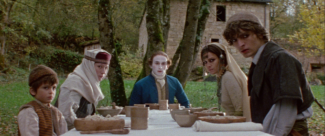The Vourdalak (Adrien Bean, 2023): France
Reviewed by Logan Surber. Viewed at the Santa Barbara International Film Festival.
The Vourdalak, written and directed by Adrien Bean, is a stylized dramatic horror period piece that follows Marquis d’Urfé’s encounter with a strange family when seeking help after getting ambushed and his discovery of their dark secrets. This screenplay was adapted from the book The Family of the Vourdalak written by Aleksey Konstantinovich Tolstoy in 1884, predating Dracula. This film is Adrien’s debut in feature-length filmmaking and his only other work that I could find was a few short films shot on Super 16 and Super 8 films. The Vourdalack attempts to change how modern horror movies can be portrayed through old stories, with an entirely practical puppet acting as the main antagonist compared to the oversaturated CGI that has taken over the horror landscape as of late.
This film follows Marquis d’Urfé, a French emissary after he gets attacked by a group of Turks and eventually finds refuge after being pointed in the direction of a small castle owned by Gorcha and his kids. His eldest son Jegor is the household leader in his absence and takes in Marquis while trying to figure out where Gorcha went. Eventually, his sister Sdenka tells Jegor that Gorcha went out hunting for a Turkish outlaw, leading Jegor to go out looking for him. Marquis goes around and familiarizes himself with all of the odd inhabitants of this household before being told to go to the dinner table for the meal the family put together. While everyone is gathering at the table outside we hear a groan coming from the bushes, Jegor goes to investigate and ends up finding a disheveled corpse-looking person who turns out to be Gorcha.
The visuals are stunningly ethereal, being shot on Super 16 film leads to the old fantasy setting that Adrien strived for but creates the challenge of having to do all the effects practically. Gorcha’s character is a practical puppet inspired by old horror thrillers of the likes of Alien and The Fly. This puppet aims for the uncanny valley of being in between human and inhuman to create unease and intrigue in the character. The puppet is a stunning practical character that feels like its own person with their motives. In an interview done by Variety Adrien says “You can’t have as many special effects because they’re real effects, but this limitation forces you to be more inventive and create characters differently so that we care about them. As my editor told me, with special effects it looks real but it feels fake, and with what we created, it looks fake but hopefully it feels real.”
The use of practical effects, both visually and audibly, really brings this film to life in its unique way, making me cringe at the grotesque sounds used to portray the Vourdalak. The glowing film look establishes this as its world filled with love, violence, and beautiful landscapes. The family dynamics and setting make me believe that one of the prevalent themes is one of generational and cultural trauma. Gorcha’s power and dominating control over his family is stated that it is through the love he feels for them. Each sibling’s style is that of a historical people/time, Piotr being more Greek and effeminate, Jegor being very masculine and controlling with the look of a village warrior from the 17th century, and Sdenka who is dressed in numerous pieces of jewelry and attempts to practice rituals of the 15-16th century western Europe. Gorcha’s control and violence out of “love” for his children is reminiscent of the previously said cities being raided and pillaged for resources. The narrative also plays into the idea of generational trauma through the destruction and forced traditional gender roles each character is told to fit in. Jegor being an “Ideal” son for Gorcha with his masculine and family-oriented thinking, nearly assaults Piotr for looking effeminate instead of only showing his masculinity.
Adrien Bean’s vision shines clearly through this film, from the puppeteering to the ethereal Super 8 footage, this adaptation is a love letter to old horror cinema. Creating an atmosphere of fear through practicality, feeling grounded and real makes it stand out in the contemporary horror landscape.
About this entry
You’re currently reading “The Vourdalak (Adrien Bean, 2023): France,” an entry on Student Film Reviews
- Published:
- 02.29.24 / 11am
- Category:
- Films, Santa Barbara Film Festival 2024

2 Comments
Jump to comment form | comments rss [?]